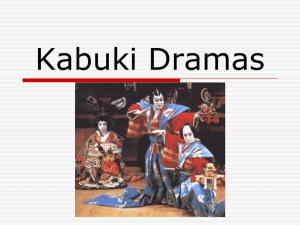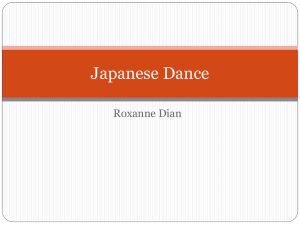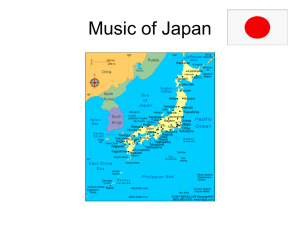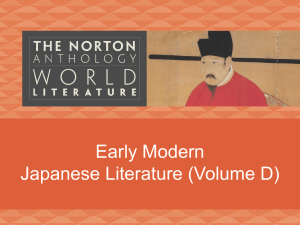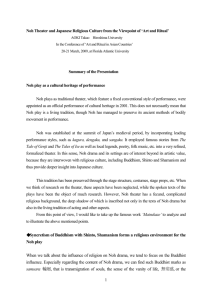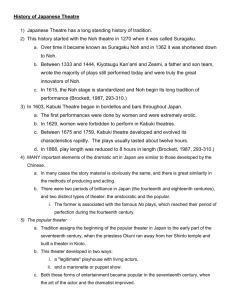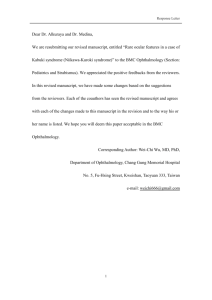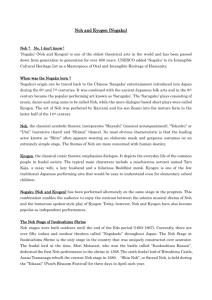Medieval Japanese Theater: Noh & Kabuki History
advertisement
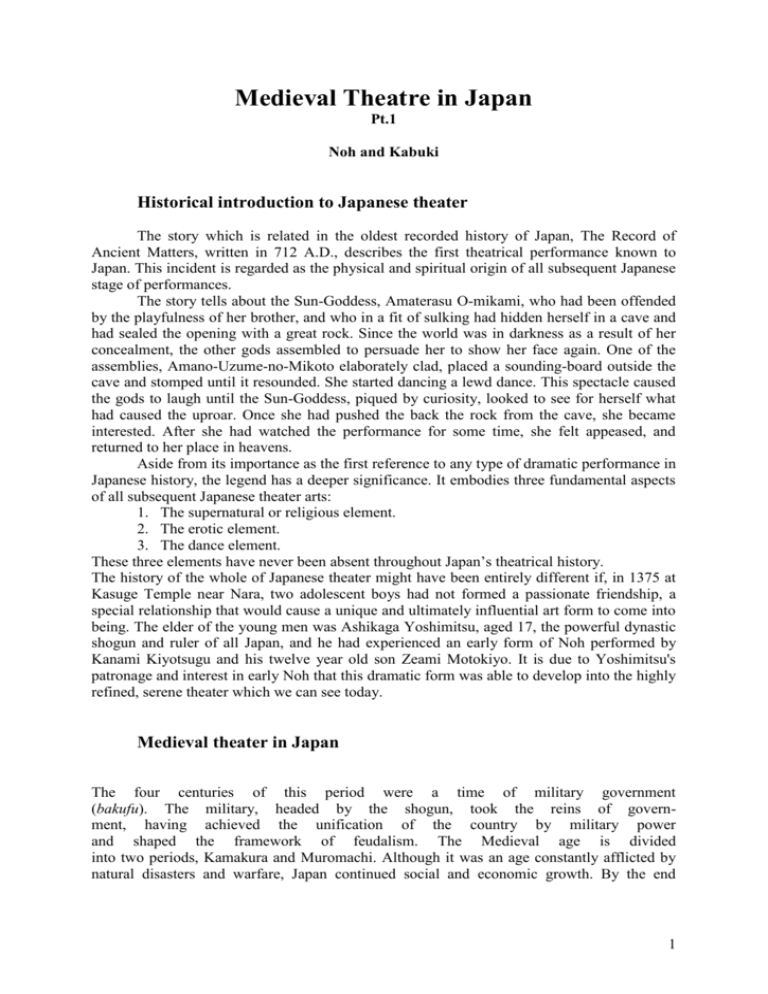
Medieval Theatre in Japan Pt.1 Noh and Kabuki Historical introduction to Japanese theater The story which is related in the oldest recorded history of Japan, The Record of Ancient Matters, written in 712 A.D., describes the first theatrical performance known to Japan. This incident is regarded as the physical and spiritual origin of all subsequent Japanese stage of performances. The story tells about the Sun-Goddess, Amaterasu O-mikami, who had been offended by the playfulness of her brother, and who in a fit of sulking had hidden herself in a cave and had sealed the opening with a great rock. Since the world was in darkness as a result of her concealment, the other gods assembled to persuade her to show her face again. One of the assemblies, Amano-Uzume-no-Mikoto elaborately clad, placed a sounding-board outside the cave and stomped until it resounded. She started dancing a lewd dance. This spectacle caused the gods to laugh until the Sun-Goddess, piqued by curiosity, looked to see for herself what had caused the uproar. Once she had pushed the back the rock from the cave, she became interested. After she had watched the performance for some time, she felt appeased, and returned to her place in heavens. Aside from its importance as the first reference to any type of dramatic performance in Japanese history, the legend has a deeper significance. It embodies three fundamental aspects of all subsequent Japanese theater arts: 1. The supernatural or religious element. 2. The erotic element. 3. The dance element. These three elements have never been absent throughout Japan’s theatrical history. The history of the whole of Japanese theater might have been entirely different if, in 1375 at Kasuge Temple near Nara, two adolescent boys had not formed a passionate friendship, a special relationship that would cause a unique and ultimately influential art form to come into being. The elder of the young men was Ashikaga Yoshimitsu, aged 17, the powerful dynastic shogun and ruler of all Japan, and he had experienced an early form of Noh performed by Kanami Kiyotsugu and his twelve year old son Zeami Motokiyo. It is due to Yoshimitsu's patronage and interest in early Noh that this dramatic form was able to develop into the highly refined, serene theater which we can see today. Medieval theater in Japan The four centuries of this period were a time of military government (bakufu). The military, headed by the shogun, took the reins of government, having achieved the unification of the country by military power and shaped the framework of feudalism. The Medieval age is divided into two periods, Kamakura and Muromachi. Although it was an age constantly afflicted by natural disasters and warfare, Japan continued social and economic growth. By the end 1 of the period the population of the country had reached twenty million. A unique national culture had been created on the basis of the traditional court culture, with the power of temples and shrines in its background and the militarists' viewpoint as its spirit. Drama also made great advances in concept, structure, and production, as well as in theory, and in every respect showed a strong medieval character, best represented by Noh and Kyôgen (Nohgaku). There are also two other forms of traditional Japanese theatre that are famous around the world. These are Kabuki and the Bunraku, or puppet theatre. Noh Theater Noh is the culmination of several dance-drama forms which preceded it. It amalgamates within itself a variety of techniques and influences. The result is a synthetic and near perfect art form. It embraces people’s folk dance, temple entertainments, a blend of Dengaku and Sarugaku (i.e., a well-proportioned balance between dance and mime with the emphasis on representation and plot), moral instruction infused by the priests, and, lastly, the refinement from patronage by the nobles. Noh theater traces its origins back to the eight century. Its underlying purpose is not entertainment as much as a desire to preserve Japanese culture and to exploit the principal motives of Buddhist thought. Everything about a Noh performance is slow, ceremonial, and dignified. A performance of Noh is not a performance of realistic theatre. Rather, its movement is highly stylized and prescribed. While some gestures have specific meaning, others serve as an abstract aesthetic expression to convey the emotions of the main character. All of Noh can be described as dance. Sometimes there is very little movement as dramatic tension is built mainly through narration. At other times there is strong, vigorous movement. Movement takes place sometimes to the singing of the chorus or sometimes to purely instrumental music. In general, deliberateness, brevity, suppression and abstraction are important features of Noh movement. Classification of Noh plays There are about 250 Noh plays still in existence. Of these scarcely half are normally performed. Noh is grouped roughly into five main classifications, according to the subject matter or central character of the play. These five classifications are Shin (God), Nan (Man), Nyo (Woman), Kyo (Madness) and Ki (Demon). In practice these groupings mean: 1. God plays 2. Warrior-ghost plays 3. Women plays 4. Plays of insanity – women, however, are usually the protagonists 5. Demon plays Plays which do not fall precisely into any of these categories are lumped in category 4 which may also be called genzai mono. Group 4 is actually a completely miscellaneous group. Okina (or Kamiuta) is a unique play that combines dance with Shinto ritual. It is considered the oldest type of Noh play, and is probably the most often performed. It will generally be the opening work at any programme or festival. In general the pattern of Okina action is the same. A star actor without make-up slowly enters the stage; from a black and gold lacquer box, tied with thick purple cord, he removes the bearded wooden mask of a face withered with age. 2 This represents Okina, a symbol of long life. The actor tries the mask to his face and intones strange words which are nowadays incomprehensible. At the same time he dances a slow and dignified series of movements, carrying in one hand a fan. The musical accompaniment is provided by two drums and a flute. After this opening section, Senzai, a bright but reserved character enters. He is invariably dressed in an elaborate costume of blue on which the white stork, a symbol of good fortune and eternity in Japan, has been embroidered or woven. Senzai dances in a somewhat livelier mood. The enters Samba, a comic, semi-mystic figure, dressed in a conical hat of black and silver with a large red dot painted on it, and grand brocaded clothes. He carries the Buddhist juzu, or handbells, which he rings in somewhat sacrilegious mock piety. Samba capers about the stage in a virtuosic swift dance of youthful abandon. Symbolically, Okina dances represent three stages of man’s existence on this earth, and are presumably rites to enhance the possibility of a long life. Structure of Noh plays The formula for the construction of all Noh dramas is rigid. No matter how the individual content of each play differs, the outline of the play’s framework is invariable. Instead of three acts, each Noh play has three sections called Jo, Ha and Kyu, a beginning, a middle and an end.Action in a Noh play is generally recollected and the plot hinges on an event that has already taken place in the past. This means that the dramatic situation is not necessarily acted realistically before one’s eyes. Rather it is poetically recalled and discussed by the characters and chorus, and their movements become dreamlike glosses to the idea carried by the words. Each character introduces himself (and others, if necessary) by words, so that an actual dramatic situation on the stage to serve this purpose becomes inessential. Each character also lays the setting in words because Noh is enacted on a bare stage with only a pine tree painted on the permanent wooden backdrop. In addition, a chorus to the side and musicians at the back of the stage further contribute an explanation of the situation, mood, feelings or action by words and musical sound. A skeleton outline common to all Noh dramas is as follows: Jo – the opening section starts with the entrance of the side character or foil (waki). He introduces himself by name, rank, and states his purpose for appearing. There ensues a “travel song” (shidai). During the shidai which is sung by the chorus, the side-character moves, and it is understood that he has reached his destination. The protagonist (shite), who may also be accompanied by followers (tsure), then enters; he is frequently a character in disguise. The protagonist and the side-character converse. Through their conversation the plot is laid, and the audience is informed of all events and tensions necessary to the theme og the play. Ha – during the middle section, the protagonist dances what is technically called kuse. The dance usually represents in stylized action a physical re-enactment of a prior event. He retires from the center of the stage. A comic interlude performed by characters who speak in informal and colloquial language then follows. Kyu – the final and most dramatic section is when the protagonist re-appears; this time in his true colors; often as a ghost or demon. He dances a climactic dance, resolving the plot, and the play ends. Performers, chorus and musicians silently leave the stage. Stage, Costumes, Masks and Music 3 STAGE - A square platform supported on pillars, open to the audience on three sides, and covered with a temple-like roof, forms the stage for a No play. It is connected with a green room by a corridor, or gallery, which leads back from the stage at the left, as the audience sees it. Here part of the action takes place. Upon the back scene is painted a pine tree, and three small pines are placed along the corridor. The actors are highly trained, and their speech is accompanied by soft music. There are rigid rules for acting, each accent and gesture being governed by an unchanging tradition. The actors are always men, wearing masks when impersonating females or supernatural beings. (Picture) COSTUMES - The oldest surviving Noh garments date from the 15th century during the reign of the sixth shogun, Yoshimasu (reigned 1440-1473). The particular costume worn by the actor depends on the role played. Thus, a certain kind of costume indicates a certain kind of character type such as a young woman, a handsome man or a demon. The color of the Noh costumes is important. White is considered to be the most dignified color and is used for characters of nobility. Brown is considered to be the least dignified color and is used for servants and country people. Red is worn by young girls and older women wear darker colors. Light blue indicates a quick temperament. Dark blue indicates an extroverted person. Light green is used for menials. One of the types of costumes is the kara-ori. It is usually worn to indicate a female but sometimes can be used to indicate a very elegant young man. (picture of kara-ori) Other types of costumes include the atsuita, for male roles. Another type of costume is worn to indicate aristocratic gentlemen, Shinto priests and divine beings and is called the kariginu. Costumes used to indicate deities and men of high rank are lined, the ones worn to indicate Shinto priests are unlined. Undergarments used when playing female roles are referred to as nuihaku and surihaku. A kara-ori is worn over these. (Picture – undergarment) MASKS - Makeup is not used in Noh. Rather, delicately carved masks are usually used by the shite main character and/or the tsure attend-ant. These masks are considered objects of superb beauty as well as powerful means of expression. Any character being portrayed which is not a middle aged man living in the present will wear a mask. There-fore all characters portraying women and old men wear masks as well as supernatural beings such as ghosts, deities, demons, and divine beasts. In general, masks either have a more or less neutral express-ion or portray a very strong emotion. The former in fact allows the mask a variety of expression with the play of light and shadow on it as the actor changes slightly the tilt of the mask. MUSIC - Instrumentalists known as hayashi sit at the back of the stage. They consist of a transverse flute (nohkan), an hourglass-shaped drum held at the shoulder (kotsuzumi), a slightly larger hourglass-shaped drum placed on the lap (okawa or otsuzumi), and a barrelshaped drum placed on a small floor stand and played with two sticks (taiko). The rhythms and melody of these instruments follow highly prescribed systems. One particularly unique feature is the use of drum calls (kakegoe), the shouts or cries of the drummers which serve as signals between the drummers as well as between the drummers and singers. These drum calls also add an important element to the sound texture of the performance. 4 Characters The main character of a Noh play is called the shite (pronounced sh'tay) who sometimes appears with one or more companion char-acters called tsure. In many plays, the shite appears in the first half as an ordinary person, departs, then appears in the second half in his true form as the ghost of famous person of long ago. The former is called the maejite and the latter the nochijite. They are traditionally performed by the same actor. The secondary actor, the waki, is often a travelling priest whose questioning of the main character is important in developing the story line. He also often appears with companion waki-tsure. An interlude actor called ai or ai-kyogen also often appears as a local person who gives further background to the waki, and thus to the audience, in order to understand the situation of the shite. A chorus called jiutai, usually consisting of eight persons, sits at the side of the stage and functions to narrate the background and the story itself. It also sometimes describes the character's thoughts and emotions or even sings lines for the characters. Development of Noh theater Two geniuses, Kan’ami Kiyotsugu (1333-1384) and his son Zeami Motokiyo (1363-1444), perfected Noh. Under the exalted protection of the Ashigaka Shogun, the supreme ruler toward the end of the 14th century, these two men evolved Noh art. Had it not been for Zeami even more than his father, Noh would hardly have merited the enduring attention it has received. Zeami is the prime figure in Noh, having written a vast quantity of plays for his troupe to perform, many of which are still regularly performed to this day. He also wrote a very famous treatise in 1423 on the skills and methods necessary for a Noh actor, and that document is still valid study for young actors. What Zeami, inspired by his father, managed to create, was a theater of the Muromachi period (1336-1573), written in the upper-class language of the fourteenth century, but which looked back to the supposed Golden Age of the Heian Period (794-1185), by basing plays on people, events and even poetry of that era creating texts of astonishing richness and opacity. Kabuki Kabuki is a form of traditional Japanese theater. Kabuki theater is known for the stylization of its drama and for the elaborate make-up worn by its performers. Kabuki is sometimes translated as "the art of singing and dancing." Kabuki has changed drastically since its earliest incarnations. 1603-1629: female kabuki: 5 The history of kabuki began in 1603, when Okuni, a miko (young women in the service Shinto shrines) of Izumo Taisha, began performing a new style of dance drama in the dry river beds of Kyoto. Female performers played both men and women in comic playlets about ordinary life. The style was instantly popular; Okuni was even asked to perform before the Imperial Court. In the wake of such success, rival troupes quickly formed, and kabuki was born as ensemble dance drama performed by women — a form very different from its modern incarnation. Much of its appeal in this era was due to the ribald, suggestive performances put on by many of the imitators; this appeal was further augmented by the fact that they were often also available for prostitution. For this reason, kabuki was also written as singing and dancing prostitute during the Edo Period. 1629-1652: young male kabuki The raucous and often violent atmosphere of kabuki performances attracted the attention of the ruling Tokugawa shogunate, and in 1629 women were banned from the stage for the stated purpose of protecting public morals. Some historians suggest that the government was also concerned by the popularity of kabuki plays that dramatized ordinary life (rather than the heroic past) and enacted recent scandals, some involving government officials. Since kabuki was already so popular, young male actors took over after women were banned from performing. Along with the change in the performers' gender came a change in the emphasis of the performance: increased stress was placed on drama rather than dance. Their performances were equally ribald, however, and they too were available for prostitution (also for male customers). Audiences frequently became rowdy, and brawls occasionally broke out, sometimes over the favors of a particularly handsome young actor, leading the shogunate to ban young male actors in 1652. After 1653: men's kabuki From 1653, only mature men could perform kabuki, which developed into a sophisticated, highly stylized form called yarō kabuki "men's kabuki". This metamorphosis in style was heavily influenced by kyoge comic theater, which was extremely popular at the time. Today the "yarō" has been dropped, but until relatively recently, all roles in a kabuki play were still performed by men. The male actors who specialize in playing women's roles are called onnagata or oyama. Onnagata typically come from a family of onnagata specialists. Two other major role types are aragoto (rough style) and wagoto (soft style). 1673-1735: The Genroku period During the Genroku era, kabuki thrived. The structure of a kabuki play was formalized during this period, as were many elements of stylization. Conventional character types were determined. Kabuki theater and ningyō jōruri, the elaborate form of puppet theater that later came to be known as bunraku, became closely associated with each other during this period, and each has since influenced the development of the other. The famous playwright Chikamatsu Monzaemon, one of the first professional playwrights of kabuki, produced several influential works, though the piece usually acknowledged as his most significant, Sonezaki Shinju (The Love Suicides at Sonezaki), was originally written for bunraku. Like many bunraku plays, however, it was adapted for kabuki, and it spawned many imitators — in 6 fact, it and similar plays reportedly caused so many real-life "copycat" suicides that the government banned shinju mono (plays about lovers' double suicides) in 1723. Ichikawa Danjuro also lived during this time; he is credited with the development of mie poses and mask-like kumadori make-up. In the mid-18th century, kabuki fell out of favor for a time, with bunraku taking its place as the premier form of stage entertainment among the lower social classes. This occurred partly because of the emergence of several skilled bunraku playwrights in that time. Little of note would occur in the development of kabuki until the end of the century, when it began to reemerge. Elements of kabuki The kabuki stage features a projection called a hanamichi (flowery path), a walkway which extends into the audience and via which dramatic entrances and exits are made. Kabuki stages and theaters have steadily become more technologically sophisticated, and innovations including revolving stages and trap doors, introduced during the 18th century, added greatly to the staging of kabuki plays. In kabuki, as in some other Japanese performing arts, scenery changes are sometimes made mid-scene, while the actors remain on stage and the curtain stays open. Stage hands rush onto the stage adding and removing props, backdrops and other scenery; these stage hands, known as kuroko, are always dressed entirely in black and are traditionally considered "invisible." There are three main categories of kabuki play: jidai-mono ("historical", or pre-Sengok period stories), sewa-mono ("domestic", or post-Sengoku stories), and shosagoto (dance pieces). Important characteristics of Kabuki theater include the mie, in which the actor holds a picturesque pose to establish his character. Keshō, or makeup, provides an element of style easily recognizable even by those unfamiliar with the art form. Rice powder is used to create the white oshiroi base, and kumadori enhances or exaggerates facial lines to produce dramatic animal or supernatural masks for the actors. 7

